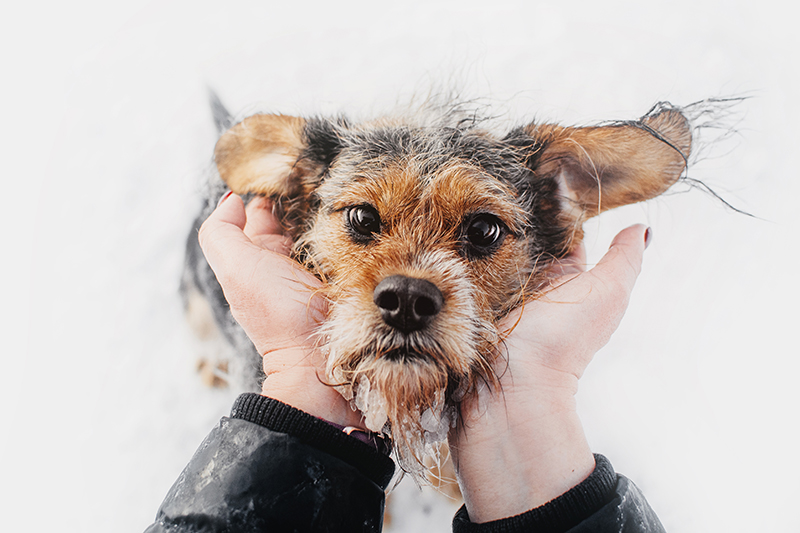What should you do if you see an animal out in the cold?
As animal lovers, one of the most heartbreaking things to see is a helpless animal trapped in an unsafe situation. There has been growing awareness and media attention to dogs, in particular, left in vehicles in hot weather. There doesn’t seem to be as much discussion around animals exposed in cold weather, however. In some cases, the cold can be just as deadly as the heat.
It isn’t just the temperature that’s dangerous, it is also heavily influenced by exposure. For example, a cat sleeping in a soft bed in a cold but dry, weather-proof garage is in a very different situation than a cat sleeping on the ground under a porch, where draughts and damp could get to them. Similarly, a dog in a fenced in yard or run with an insulated, weather-proof dog house is in a very different situation than a dog chained by their collar to a post in an exposed yard with no shelter from the wind, rain or snow.
Of course, there are other factors as well, not just the environment, but the animal themselves. Feral and stray cats have adapted exceptionally well to the habitats they have been introduced to and grow thick winter coats to protect themselves. Some pet cats that live indoors and outdoors may still chose to go outside even in weather we wouldn’t dream of going out in. However, some pet cats clearly aren’t equipped for cold climates – think shorthair, rex and hairless sphinx cats! There are some dogs, particularly the thick-coated Nordic type breeds who may actually prefer to be outside, even in the cold and snow. Huskies, mountain dogs and livestock guardians may actually be a challenge to bring in when we think it is too cold outside!
So, with these things in mind, what should you do if you see an animal out in the cold?
First, assess the situation
- What kind of an animal are you looking at – are they a chihuahua or are they a Siberian husky? Young, elderly and particularly small dogs and cats are at greatest risk.
- Where are they – are they outside and exposed to the elements, or do they have access to appropriate shelter?
- Where are their family – is this animal outside a home or are they wandering?
- Do they look affected by their situation – are they running around playful, curling up comfortably, or are they shivering or whining?
What does hypothermia look like?
If you’re worried that the animal isn’t one who can stay outside long, if they don’t have appropriate shelter or if they look like they are cold, take a closer look if you can. In dogs and cats, hypothermia presents with the following signs:
- Tiredness
- Shivering
- Pale skin – this can only be seen in areas with little or no hair like the undersides of the ears, paws, belly and gums
- Muscle stiffness – this may look like soreness, lameness, limping, or general stiff movement
- Shallow and/or very slow breathing
- Frostbite – the skin of the paws, ears and tail are most vulnerable and will feel cold and firm to the touch and be pale grey or blue in color
- Mental dullness – can progress to coma
What can I do if I’m worried?
- See if you can identify the animal’s family. Alert them about your concerns about their pet.
- If the animal is in their home environment but you are concerned that they are being left in inadequate conditions you should contact your local humane authority – for some this will be the ASPCA, the Humane Society, or the local municipal shelter.
- If you believe that the animal is in grave danger, if they are showing signs of hypothermia, advise the humane authority and/or call the police if necessary. Remember, animals are legally considered to be physical property, which means you do not have the authority to remove the animal from their home without the owner’s consent, only authorized agents may do so. Do not put yourself at risk.
- Urgent care:
- Move the animal somewhere warm and dry. Wrap them in warm (not hot) blankets or towels.
- Do not try to reheat them too quickly, slowly and gently warm them up.
- Do not apply hot water bottles or use electric heating pads, these can burn the animal and they may be too weak to move away.
- Do not try to feed them anything right away. First, offer water at room temperature.
- Bring the animal to a veterinarian – either your family veterinarian or an emergency clinic – as soon as possible.
Be safe and make sure you do not put yourself at risk. Scared animals can be more likely to bite out of fear, so if you intend on handling strange animals, be sure to wear appropriate clothing and personal protective gear. Better yet, if the situation allows, call your local humane authority and an animal control officer can come help.
Thank you for caring; stay warm and keep your fur family safe with you.
Dr. Sarah Dodd

